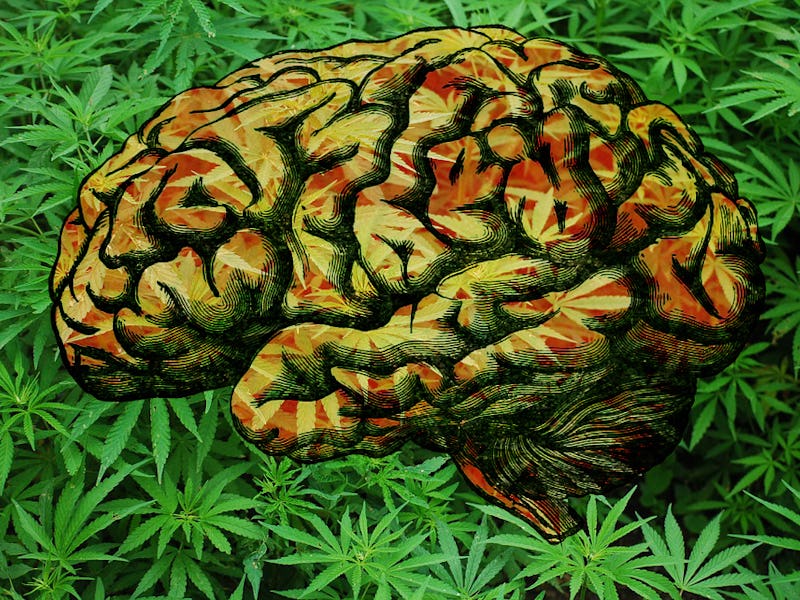Blame Cannabinoids For Giving You That Sweet, Sweet High
If marijuana is the foreman, these chemicals are the construction crew.

You might think of the process as simple: Light up a joint, inhale, let the dank gas permeate your lungs. But smoking pot is a lot more complex than you might think.
Let’s start with the cannabinoids. They’re the family of molecules — including the notorious marijuana compounds tetrahydrocannabinol (which gets you high) and cannabidiol (which might stave off Alzheimer’s disease and save 96% of NFL players from a brain injury known as chronic traumatic encephalopathy) — that get you effectively, successfully stoned. In addition to these two, there are at least 83 other cannabinoids in weed, which variously make you hungry, confuse your motor skills, incite laughter, and dull pain; outside of weed, there are thought to be around 500 cannabinoids in total.
What links all of them together is the fact that these compounds bind to receptors in the human body known as — you guessed it — the cannabinoid receptors.
Think of the receptors — there are actually two variants, CB1 in the brain and CB2 in the body — as baskets, with their openings shaped to let cannabinoid compounds in, while keeping other types of chemicals out. These receptors would exist in the human brain even if we’d never smoked up, which suggested to scientists studying weed’s effects in the 1980s that there must be a naturally occurring chemical in the body meant to collect inside those baskets.
The high-inducing compound in marijuana, THC, mimics the naturally occurring molecule anandamine. Both lead to the release of dopamine.
They were right: The human body naturally produces endocannabinoids, a subset of cannabinoids that play roles in the ways we eat, feel pain, experience emotions, remember and forget. A sober persons cannabinoid baskets are constantly being filled with and emptied of its endocannabinoids, which sets off varying signals to different regions of the brain, depending on which molecule binds. By doing this, they help maintain a state of mental and physical balance otherwise known as homeostasis.
When you smoke weed, this state of balance is thrown slightly off-kilter, for better or for worse — you may feel like you’re on cloud nine, for example, but find it especially difficult to walk. The cannabinoids derived from marijuana are known, aptly, as plant cannabinoids (there’s a third subset of synthetic ones, found in terrifying drugs like spice and K2). On a chemical level, these look a lot like the endocannabinoids the body makes, which is why the body’s receptors are happy to scoop them up when they course through the bloodstream.
Okay, so you’re stoned. What’s going on in your head? THC, the psychoactive cannabidiol in weed that makes you feel high, tricks the receptors into thinking it’s the naturally-occurring chemical anandamide — the “bliss molecule” — which, when it binds, normally forces the body to release a bit of dopamine. The biggest difference between the two is that THC, the great imitator, is really good at overstaying its welcome, so more dopamine than usual ends up being released — hence, the unusual psychological effects.
Dopamine, despite it’s reputation, isn’t all fun and games. While it is the major driver of our brain’s reward and pleasure system — allowing us to enjoy food, drugs, and sex — disregulation of its normal levels has been linked to aggressive behavior) and to reduced risk-taking behaviors. Rather than think of dopamine release and bliss as a linear correlation, it’s much more accurate to think of it as a chemical whose balance is important to maintain. Anandamide is better regulated by the body, meaning that our cannabinoid baskets know when they’ve held on it for too long; if it weren’t, we would probably just be high all the time.
There’s plenty we still don’t know about the cannabinoids. Ongoing research has shown that they might have therapeutic effects for people living with PTSD, speed bone healing, and even improve night vision — but at the same time, synthetic cannabinoids are responsible for dozens of drug-related deaths. The seeming duplicity of the cannabinoids mirrors the potential for treachery of the chemicals naturally occurring within our own bodies.
This just goes to show that it’s never substances themselves — whether marijuana, opioids, or psychedelics — that are “bad”. It’s how — and to what degree — we use and abuse them that matters because that, in turn, determines how our bodies will respond in kind.